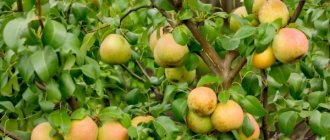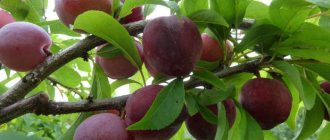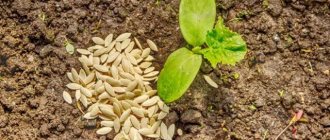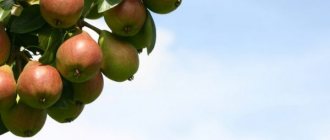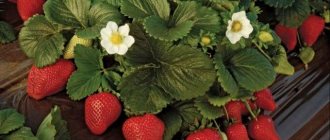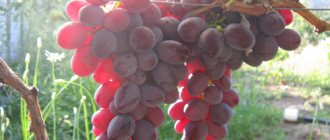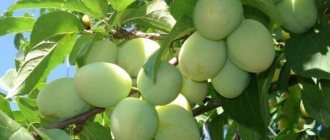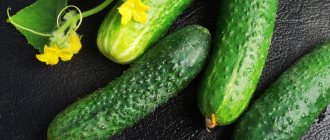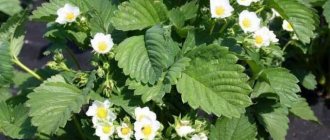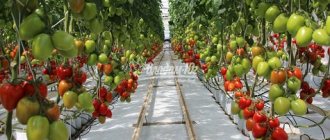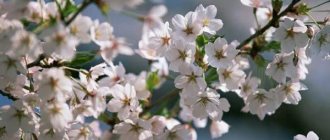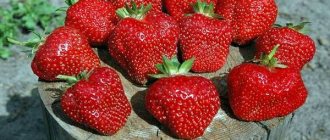Cherry Volochaevka: description of the variety
Cherry Volochaevka: photo of the variety
Today, cherry plantings have become very symbolic for personal plots, which are located in different parts of our country. But over the past half century, some changes have occurred - due to an outbreak of infectious and fungal diseases, almost two-thirds of cherry orchards and crops across the country were simply destroyed.
The more famous and famous varieties cannot cope with the pressure of diseases and external influences, and therefore gardeners strive to create completely new plantings that will withstand the onslaught of pests and common infections, and will not lose their varietal and species uniqueness. The old ones have been replaced by completely new varieties, and they really deserve attention from gardeners and gardeners who would like to support the domestic classics and grow famous cherry trees on their site.
One of these relatively new, but already beloved varieties is the Volochaevka cherry. Breeders purposefully sought to create such a plant, since they perfectly understood that they were able to create a variety that could satisfy all their needs, interests, and taste wishes. The Volochaevka cherry variety was obtained not by one breeder, but by a whole group of specialists, the leader of the group is considered to be A.I. Evstratov. The Volochaevka cherry variety itself was bred at the Federal State Budgetary Institution VSTISP, where breeders worked and work every day to create completely new varieties with unique features and characteristics.
A little about the institute where the Volochaevka cherry was bred - it is located in Moscow, and the head of the group, breeder A.I. Evstratov is also known for the fact that he is the author of a very large number of different cherry varieties, which today enjoy great love and popularity among gardeners and gardeners all over the world. In addition, Evstratov varieties are distinguished by a very high level of immunity and resistance to diseases and infections, and attacks from pests.
Volochaevka cherry is also unique in that this variety was obtained from crossing very famous and, most importantly, beloved varieties that have existed for a long time - Vladimir and Lyubskaya cherries. Volochaevka cherry took only the best characteristics from its parent crops, and therefore it is truly considered one of the most sought-after and one of the most desirable in modern horticultural culture.
But still, the variety has its own special features and characteristics, which we will talk about in a little more detail, because it is necessary to take into account any subtleties of planting, care, and features of the plants themselves that need to be taken into account. Only in this way will the gardener understand more clearly how to care for the planting, what conditions it needs in order to produce the maximum yield with useful taste characteristics and properties.
The Volochaevka cherry variety was obtained by breeders in the 80s of the last century, but due to the fact that the country did not have the most favorable socio-economic and political conditions, the variety was registered in the state register only in 1997, and since then it has been began to be actively cultivated in the Central region.
Cherry Volochaevka: characteristics of the variety
Cherry Volochaevka: photo of the variety
Cherry trees of the Volochaevka variety can be medium in height, but there are gardeners who say that in general these are quite large plantings. The height of the Volochaevka cherry varies from 3 to 3.5 meters. It all depends on the area and under what conditions the variety grows, since many factors can influence its growth. Some of them are generally supported by gardeners, and some, less favorable ones, should be constantly fought, because the vital activity of the planting, its strength and ability to produce as much quality and abundant, tasty and healthy harvest as possible will depend on this.
The crown of the Volochaevka cherry turns out to be incredibly attractive - it is round, dense, and consists of a large number of bright dark green leaves. The twigs and shoots are literally covered with them, and at the same time the Volochaevka cherry really deserves attention. It becomes a kind of universal - not only does the cherry tree produce a harvest, but it can also demonstrate very decorative and attractive characteristics. Of course, the crown can be shaped, it can be trimmed, thanks to which you can create a shape that will meet any desires and needs of the gardener.
The peculiarity of the Volochaevka cherry variety is that after pruning the tree recovers remarkably well on its own. The leaves have a crenate edge and are slightly above average in size, but in general many experienced gardeners say that they are quite large and are able to stand out against the background of other parts of the tree, and even against the background of many other cherry varieties.
The shoots are straight, colored brownish-brown. Fruiting of the variety usually begins on last year's shoots, and fruits can also form on numerous bouquet branches. The most important thing is to constantly monitor the condition of the planting, to prevent the development of unfavorable characteristics and diseases, and also to ensure that the cherries are under no circumstances affected by pests.
Young shoots of the Volochaevka cherry, which were formed this year, bear only vegetative buds, but next year they will begin to bear fruit, so it is recommended to constantly monitor their growth and, if necessary, prune them so that the plantings feel more comfortable and safe. In addition, the overall appearance of the tree will depend on pruning, so you should be as careful as possible with all this. But we’ll talk about this a little later, when we move on to the part with agricultural technology and caring for cherry plantings.
Choosing a suitable location on the site
For successful cultivation, it is important to choose not only a site that is suitable in terms of parameters, but also neighbors.
- Unfavorable neighbors for cherries:
- peach;
- raspberries;
- gooseberry;
- currant;
- Solanaceae.
These crops share common insect pests. You should also not plant cherries next to tall growing trees: pear, ornamental coniferous trees, apple trees. In addition to the fact that they will shade Volochaevka, their root system is too spreading, so the cherries will be deprived of nutrition and moisture.
Lighting
The south-eastern and southern sides of the site are illuminated better and longer. Ideally, cherries grow well on slopes; when planting, you can make a mound on a flat surface. With shading, even slightly, the taste of the berries will be more sour than sweet. It is good if the tree is protected from the wind by a fence.
Priming
Closely located groundwater creates a risk of root rot, so its location should be no closer than 1.5 m to the soil surface. The culture grows well on drained, fertile soils with an acidity reaction closer to neutral (6.5–7 pH).
What fruits does the Volochaevka cherry variety produce?
Cherry variety Volochaevka: photo
Judging by the fact that gardeners leave a fairly large number of reviews about this variety, the Volochaevka cherry is distinguished by the fact that the fruits on it are very large. But the originator initially indicated in his description that the fruits are miniature - one Volochaevka cherry reaches a weight of no more than four grams. But even here it is worth saying that assessments of external characteristics are always quite subjective, and gardeners who have not previously grown cherries on the plot can evaluate the result obtained and the harvest as plentiful, and the berries as incredibly large in size.
All that remains is to understand that in any case, the maximum result can be achieved, but at the same time it is necessary to invest your own time and effort so that in the future the planting feels as comfortable as possible, and so that in conditions of a harmonious microclimate the tree does not fight for its existence, but calmly devoted all her strength to the formation of the harvest.
We can conclude that the size of the Volochaevka cherries, as well as their external characteristics and the abundance of the harvest, are all determined by climatic and temperature conditions, as well as the area in which the planting grows, and whether it received enough care from the gardener. Of course, you should initially carefully study the information about the varieties and their characteristics, so that in the future it will be easier for you to decide whether the gardener wants to plant this variety and whether he will be able to devote his time to caring activities. But practice shows that even without this, sometimes plantings feel quite favorable, since sometimes it is enough just to create a normal microclimate for the plant so that in the future the cherries will simply bear fruit. The composition of the soil is also very important, and we will definitely talk about this a little later.
Preparatory work
The site for planting is prepared in the fall. Acidic soil needs to be limed: 400–500 g of lime are added per 1 m² before digging a hole, during digging. If the soil structure is heavy and does not allow moisture to pass through well, you need to make drainage from a mixture of gravel and sand about 10–15 cm high.
A hole is dug with dimensions of 60 × 60 × 60 cm. If several trees are planted, the distance between the holes is left at 3 m. The soil extracted from the hole is mixed with humus (15 kg) and wood ash (0.5 kg) and placed at the bottom.
The planting hole is dug with dimensions of 60×60×60 cm. Before planting, the seedlings are also prepared:
- The roots are inspected and damaged areas are removed.
- Dried root shoots are moistened by placing them in water for a couple of hours.
- Then place it in a solution of any root stimulator for 6–8 hours.
Cherry Volochaevka: reviews from gardeners about the variety
Most gardeners claim that Volochaevka cherries produce incredibly rich and very tasty fruits that really deserve attention. They have dessert characteristics and a universal purpose. But there are those who claim that this is the most ordinary cherry, which may have its own characteristics, but certainly not in external or taste characteristics.
In this case, disputes may arise, but we recommend trying to grow this variety yourself on your own plot in order to see from your own experience whether the Volochaevka cherry variety is so favorable and interesting, or whether the gardeners are right, and such cherries are no different from most other varieties that are grown on plots today.
It is always worth checking such points from your own experience, so that you can then decide for yourself whether it is worth planting cherries on the plot at all. Sometimes climatic conditions are unfavorable, the composition of the soil is not the most suitable, and in this case the harvest may not work, and even after planting the tree will not grow as actively as the gardener would like.
In terms of their hue, both the fruits and the juice that is obtained from them are distinguished by a rich red hue. This means that the Volochaevka cherry may belong to the group of so-called morels or griots. Now let’s explain what this means: all varieties of cherries, depending on the shade of the juice, can be divided into several groups - these are morels (griots) or amorels. In Morols, the juice is colored in rich shades (like in the cherry variety we are considering), but in Amorels, the juice can be very light, just like their color. So, when choosing a particular variety, a gardener should also pay attention to similar characteristics, which can play a significant role. You always want to have classic cherry plantings, but there are also those gardeners who move away from the classics and can grow exotic varieties. Moreover, there is no need to worry - even very unusual varieties today can adapt to the reality of Russian garden plots, and the harvest is no worse; many do not even see the differences.
The pulp of Volochaevka cherries is very dense, but at the same time it is wonderful - aromatic and incredibly juicy. The stone is small in size and can be separated from the pulp without any problems. Thanks to this, you can process the resulting harvest for subsequent harvests much faster and without difficulty. The tasting score is 4.7 points on a five-point scale - gardeners describe cherries as incredibly tasty and aromatic.
Also, reviews from gardeners about Volochaevka cherries indicate how useful this variety is.
The fact is that the composition of the fruits of the Volochaevka cherry is really quite rich and very useful for the human body, for its health, metabolism and immunity - the fruit contains dry substances, sugar and acids, as well as vitamin C, which has an excellent effect on various body systems person. The most important thing is that cherries are really very tasty and can be combined with other berries or fruits, especially if the gardener prepares salads or preparations.
Compliance with growing rules
Despite the fact that the Volochaevka variety is unpretentious, it is worth paying special attention to a number of mandatory rules. It all starts with choosing the right landing site. The optimal time is April. The holes are made at a distance of 3 m from each other. Their diameter and depth are 60 cm. Compliance with the specified aspect ratio allows you to form the root system in a straightened position.
Before planting, the following substances are added to the soil:
At the next stage, a peg is driven into the center of the hole, which is subsequently used to tie the seedling. As soon as the nutrient mixture is poured, the surface is carefully leveled and compacted. You need to make sure that the root collar protrudes slightly above the soil surface.
Watering and fertilizing
Recommended volume – 50 liters at a time. If the gardener uses dry mineral fertilizers, then the indicated volume increases by 1/3. Do the same during dry weather. The tree must be watered after flowering, during the fruiting period and in early autumn. One of the advantages of the Volochaevka variety is the minimum level of fertilizers that should be applied. You should not overfeed cherries, otherwise there will be more problems than benefits. When choosing fertilizers and determining the intensity of their application, it is recommended to rely on the following indicators:
in the second year, urea is added;
- in the third year, diluted nitrogen fertilizer is applied in the spring;
- Year IV is the time to add urea in the spring-summer season;
- in the fourth year, double superphosphate and potassium sulfate are added in the fall;
- V-VI year – ammophoska is added;
- Year VII – urea is added in the spring.
Read also: Rombik grapes: description of the variety
Subsequently, the gardener adds only minerals every 12 months. It is also worth remembering about liming. It is carried out every 5 years. Dolomite, limestone and chalk - a list of everything necessary for this procedure.
Regular loosening of the soil and pruning
It is done throughout the growing season. The optimal amount is 3 times. For the second procedure, a lower intensity is required - once a year. Dried branches and those that interfere with proper growth must be removed. Pruning is carried out only in spring.
Cherry Volochaevka: advantages, disadvantages, specifics of the variety
Initially, the Volochaevka cherry variety was bred as a planting that would have high immunity and stress resistance, and would be able to withstand a disease such as coccomycosis - a fungus that develops very actively and, accordingly, which can lead not only to the loss of an abundant and tasty harvest, but also to the death of the entire planting. If the year is rainy and there is a lot of heavy wet precipitation, this may lead to the tree becoming infected with fungus, but this can be avoided - it is enough to carry out preventive and health measures and treatments to make the trees feel much more comfortable and safe . If we talk about other diseases and dangerous infections, as well as pests, then in principle it is worth saying that the Volochaevka cherry has an average level of resistance to them, but still the gardener should not ignore preventive measures and treatments that will help protect the tree itself, future harvest. So you need to be very attentive to such conditions, and the result will not take long to arrive. In addition, experienced gardeners recommend organizing treatments and preventive measures in the spring, when the plant is already waking up after winter and can best accept all drugs or other substances, interventions on the part of gardeners, which can in one way or another affect the plant and its condition.
The Volochaevka cherry variety has its own advantages, but also disadvantages. Among the advantages of this planting is that the variety is absolutely self-fertile, which means the planting does not require additional pollinating varieties to demonstrate a high level of fruiting. The second advantage is that the berries turn out to be very tasty and large; much will depend solely on subjective assessments and the tastes of the gardeners themselves, so everyone should try to grow a planting on their own plot, and then decide whether the fruits are large enough and tasty enough, and is this tree worth the effort and time that the gardener himself puts into it? It is also worth saying that the yield of the variety is high, but this can only be achieved through care and attention from the gardener himself.
There is also a minus. It consists in the fact that the Volochaevka cherry variety has an average level of resistance to many diseases, and therefore, in general, the planting needs additional support and care from the gardener so that he can achieve the most favorable result. Of course, you should remember that a lot will depend on the gardener himself - the success of planting, the abundance of fruiting, and the ability to get tasty berries, so there are some subtleties that relate to planting, care and agricultural technology of the cherry variety. We'll talk about this further.
Cherry Volochaevka: protection from diseases and pests
With the onset of later autumn, the tree trunk should be coated with garden paint. This will protect the cherry trunk not only from sunburn, but also from possible pests - primarily from rodents. If the gardener knows that they have grown on the site or in nearby areas in very large numbers, then the trunk of a very young seedling should be wrapped in the first few winters. Ideally, dense materials such as plastic or roofing felt are suitable for shelter. Then the planting will not be affected by any pests. If you plant cherries in central Russia, then in principle you don’t have to worry too much about additional shelter.
Cherry Volochaevka is already in the most comfortable conditions for itself, and will experience absolutely any troubles or moments that are directly related to shelter or preparation for winter. But sometimes gardeners are advised to play it safe - to find either more suitable conditions, or to additionally protect the plants, because this is extremely necessary not only for the health of the plantings, but also for abundant fruiting and for their very attractive appearance.
There are two problems that can be quite critical for cherries - fungal diseases and pests, and both problems require either very prompt resolution, or for the gardener to implement preventive measures to protect his plantings. If the Volochaevka cherry has been affected by fungi, then it is necessary to use a biological group of drugs. Ideally, you can use a fairly effective mixture, which includes trichodermin and baxis. Throughout the summer it is worth using this drug and this mixture for spraying the crown, trunk and tree trunk area. Treatments begin after the air temperature reaches +12 to +15 degrees. In the fall, after the gardener has harvested the entire harvest, it is also worth spraying the cherry tree. A one percent solution of Bordeaux mixture is suitable for this. In this case, you should always focus on the general condition of the plantings and ensure that preventive treatments are not frequent. The plant is also regularly inspected for various diseases or pests.
Harvest and storage
Fruiting of Volochaevka begins in the 4th year of life. An adult tree produces a harvest of up to 15 kg.
Cherry is not a crop whose fruits are picked prematurely, since the berries do not ripen, remaining sour. You can’t let it overripe, otherwise most of the fruits will fall off and rot. In the southern regions, the berries ripen in early July, in the central regions - in the middle of the month, and in northern climates - at the end of July.
The collection is carried out in dry weather, in the morning or evening, when the sun is not too active. For storage or transportation, cherries must be collected together with the stem or part thereof. For further processing, the fruits can be picked without the petiole. In this case, you need to take into account that the berries will only be stored for 2-3 days, and then they will begin to deteriorate.
If the cherries are harvested during a rainy period, most likely the berries will be sour and their shelf life is much shorter. It is better to process such a harvest for winter harvesting.
For storage, fruits with petioles are placed in wooden boxes and placed in a dry room at a temperature of 0...-2°C and air humidity at 90%.
